Ep. 35 - Awakening from the Meaning Crisis - The Symbol, Sacredness, and the Sacred
(Sectioning and transcripts made by MeaningCrisis.co)
A Kind Donation
Transcript
Welcome back to awakening from the meaning crisis. Last time we were continuing our exploration of Sacredness and I talked about that in contrast, but also in concert with, Geartz’s notion of Sacredness as homing us against horror we have the proposal from Otto that Sacredness puts us into contact with the Numinous, which basically exposes us to what is horrifying. At least at the limits of us, because it has an aspect of awe with a little bit more which is to remind us - humiliation in the original sense of the word - to keep us, to give us humility to remember that as we are feeling that sense of expansiveness with awe that we are precisely, ultimately, limited creatures. And so I propose to you that these two opponent aspects of sacredness can be seen very readily within the light of the machinery of relevance realization, where the Worldview Attunement is a form of meta-meaning and therefore meta-assimilation; ultimately compression, integration, things fitting together. We get an opposite, which is the meta-accommodation afforded by confronting the numinous in awe and potentially horror and we talked about how horror is about exactly the demand, the confrontation with that, which demands from us unanswerable, unachievable accommodation.
So I propose to you that what sacredness is, is to play with, seriously play with, the machinery of relevance realization as found within the primordial aspects of Religio and that doing this would be deeply advantageous to us because it is so foundational to our agency, to the world as an arena for our action, to our capacities for self-transcendence and so forth. But caught up with that, when I invoked music as an example of this, was the idea that we often do this serious play by engaging in symbolic behavior. And so I'm putting the symbol here as something that has the capacity to function both ways: it can bring us into meta-accommodation, but of course it can also bring meta-assimilation (writes “Meta-Assimilation — Symbol — Meta-Accommodation” on the board See Fig. 1).
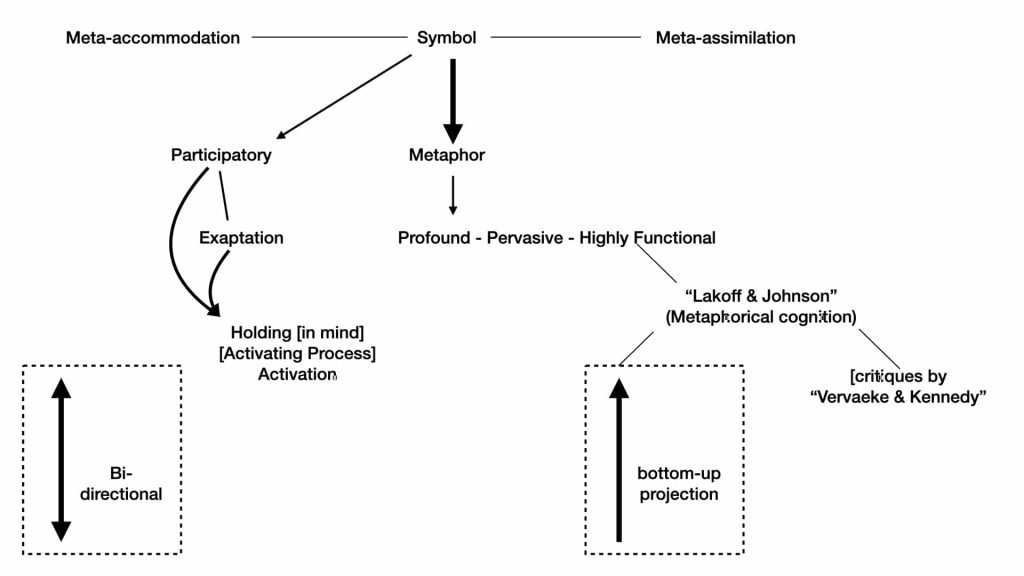 Fig. 1
Fig. 1
It can bridge between these two and it can go in both directions. And so we were starting to unpack what the symbol is (draws a big downward arrow from Symbol). And then I propose to you to, first of all, [I] emphasised its distinction from a mere sign: a Symbol doesn't just refer, a Symbol exemplifies, it has a participatory aspect to it right from the beginning. And as I've already mentioned that's going to be central to what we're talking about here, because these (both “meta’s”) are at the level of our, ultimately, our participation in the Agent-Arena transactive evolution of our relevance realization processes.
So I suggested to you that at the core of a symbol is a metaphor (adds this to the arrow down from Symbol). Already we know that this (Symbol) has to be participatory (adds this to another arrow coming down and to the left of Symbol, below meta-assimilation); we'll come back to that. And I pointed out that the metaphors we're talking about here are profound in the sense that they are pervasive in our cognition and they are highly functional (adds “profound - pervasive - highly functional” to an arrow down from Metaphor) and pointed here to the work of Lakoff and Johnson and their idea about, their work in metaphors we live by and a whole bunch of other books about how much our cognition is metaphorical. I then said there's some issues here - and this goes to some critiques made by Vervaeke and Kennedy, and Kennedy and Vervaeke - basically saying that they have this purely bottom up notion that the physical, sensory motor domain is just projected up into the conceptual. I suggested that it's more complex than that and we took a look at that and I suggested to you that instead of just the machinery of projection, which tends to be this one way, that we should think of the participatory relation as reflecting our capacity to play with exaptation (adds exaptation to participatory on the board); we can go both ways with our exaptive machinery.
Then I tried to bring all these ideas together: the notion of participatory knowing, the notion of exaptation (brings two arrows down from both to a single point), with this idea that what assemble is, [is] it's a metaphor that allows me to hold something in mind that I normally can't hold in mind. So that I can activate the machinery - the machinery that was at work in exaptation - and I can, in a sense, reverse, go back through it. I can have a symbol of a scale, and I could just stay there and think that, [but] what I can do is I can actually try to participate, perspectivally; I can engage with actually balancing. And then what I can do is reverse that process, to some degree, by which my capacity for balance has been exapted via some exaptive processing on my cerebellum, so that I actually use it to find complex contingency relationships between any areas of my brain.
So what's been happening, in fact, in neuroscience over the last 10 and 15 years is this revolution of our understanding of the cerebellum. We used to think the cerebellum was primarily about balance. And now we know that the cerebellum has all these terrific cognitive functions, because what it does is it basically… here’s (gesticulating) two areas of the brain that are often correlated together. The cerebellum picks up on trying to improve, smooth out, find the patterns of contingency and independency between them. And so what I can do is I can activate - if you'll allow me this way of talking - my cerebellum and that machinery which is precisely the machinery I need to practice the skill of being more just; I need the ability to coordinate, to find, to sense complex contingencies between multiple variables and make that better. The cerebellum is exactly the machinery I want to activate - I'm using activation as like the reverse of acceptation - I want to activate it because that will actually allow me to participate in the processing that will allow me to cultivate the skills that will make me just, that will then ultimately ground my conception of justice.
So this holding in mind (adds “holding - activation” to the double arrow), activating process allows me to deeply participate in justice, because I'm literally becoming more just! The Symbol is affording me, by making use of the exaptation machinery, which is - do you see that this (participatory side) is bi-directional in a way in which the projection (bottom up side) isn't - The Symbol is doing that for me in a powerful way. And you're saying, “Wow, this is so… Ahhhhggg, really? Come on!!!” Okay… You are much more symbolic, in a participatory fashion, than you might think. Okay, look at these quickly:
Without thinking, which one is “Buba” and which one is “Kiki”?
Which one is Buba, which one is Kiki?

Fig. 2
Overwhelmingly - and I mean [overwhelmingly] because this experiment has been done by Ramachandran (The Emerging Mind & The Tell Tale Brain) and others - this is Buba and this is Kiki (indicates which is which on the board - you know!!!). I do this all the time in my class! What's going on there? Why is this Bubba and this Kiki? You've never heard these words before! They don't mean anything to you! And people will say things like, “Well, this is sharp and spiky (the ‘star’). And so is this (the word Kiki)!” And I say to them, “what do you mean? How is this sharp? I can't cut myself on it. And how is this sharp and spiky (the word)?” And they're doing all this bridging and this cerebellar coordination between different sense modalities and different ways of acting, and you're doing it like that (dramatically claps hands)! There it is! Now, this is playful, right? I'm just activating it to no purpose, but of course I can activate this machinery to a purpose. That's what I'm doing when I'm holding up the scales! But you have to participate in it, you have to live with the symbol. You have to internalise it. It's almost like you have to savour it. One of the things we need to pay more attention to, I would argue, is the work of Jonathan Pageau. I mean, his work on the symbolic world is largely about trying to get us to remember the symbolic aspects of our existence. And I mean this in a deeply respectful way, and I hope Jonathan takes it that way: to get us to savour the symbolic and how deeply functional and active it is in us.
So symbols are participatory in this fashion that I've tried to explain to you, and then because of that, symbols have a capacity to put us into this relationship with something. So here's justice, here's the symbol, here's me (writes: “Me Symbol justice” (Fig. 3)), and as I've tried to argue, we've got the symbol, and what it's doing is it's actually transforming me in a powerful way (see Fig. 3, arrow 1). It is reactivating, reconfiguring my machinery so that I become capable of interacting with the world, so that I now start to be able to see through this symbol (Fig. 3, arrow 2) - here's the original m[etaphor]; remember how you’re looking through the pig at Sam? - I'm looking through, which means beyond and by means of, the symbol (gestures along arrow 2). I get to see more and realize and make more justice. So, I'm becoming (gestures along arrow 1), I'm activating the machinery of balance that's allowing me that perspectival awareness that’s sensitizing me to the contingent relationships between variables; it's actually helping me to cultivate the skills of justice. And of course, as I start to get better contact with [justice], [it] is disclosing itself in a new way (fig 1, arrow 3) and it discloses itself more through the processing I'm doing.
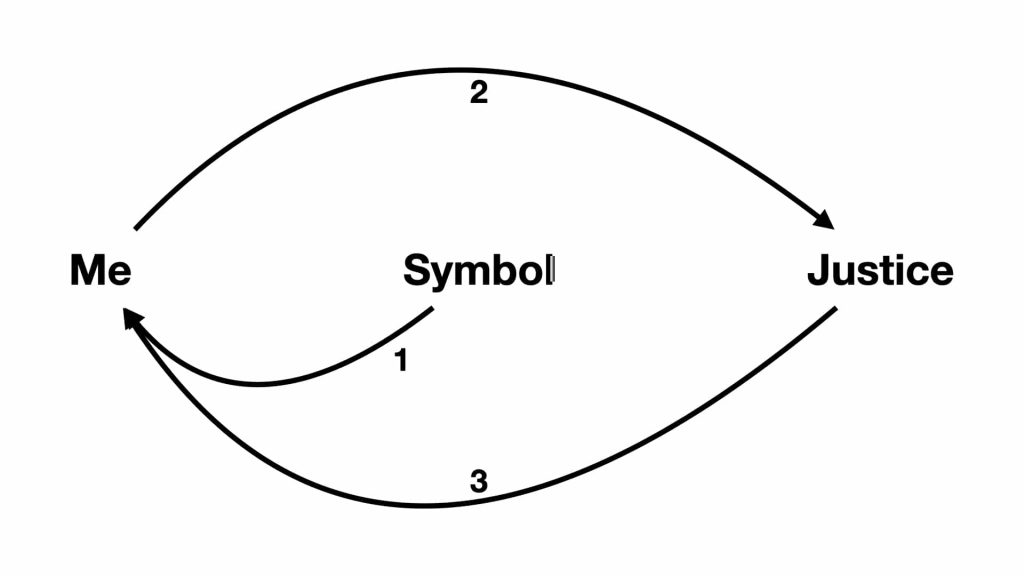
Fig. 3
Meditation As An Example Of Breath As A Symbol
And so what starts to happen is this interesting thing that's going on. So let me try and give you another example of this, and let's use something at the other end, something that's not so conceptual, at least in one sense. So I'm meditating and I'm following my breath in meditation, breathing in and out following my breath. Some of you have seen, perhaps, the videos I've given on the instruction on how to practice Vipassana. Now what's happening is normally I am focusing on my breath, and that act of focusing and following my breath is helping me to scale down, and we've talked about that; [to] scale down my attention. And for a long time, it can stay that way. But what can happen is I can become sensitized by scaling down - because you increase your sensitivity - to how much in process my mind is. So I'm normally thinking of my mind as a thing. I might even think that my mind is a container that contains things! Like, here's my mind (gesticulating) and in it is an experience of pain, for example. But when I practice watching my breath, I start to realize that that's - I start to realize - that that's not actually how my mind is unfolding!
My mind really isn't like a container in that sense. It's much more like my mind is a very fine grained process! And even something like pain isn't a thing; there's ‘paining’. And it's multiple. When I'm watching my pain, for example I've got a pain in my leg while I'm meditating, there's all these different layers. There's all these things unfolding and happening in a complex fashion. It really isn't a noun as much more like a verb. And it's really not something I possess. It's really much more something I participate in. So, do you see what I'm saying? The breath starts to become a participatory symbol of the impermanence of things, how much they are interconnected and flowing! And that can then have an impact on my sense of myself! …that maybe I am much more impermanent and interconnected. And so the breath can become, in that sense, symbolic for me. I can start to see [-] through the breath (Fig. 3, arrow 2) into impermanence and interconnectedness and I start to look back (Fig. 3, arrow 3). And so what's happening - now, you can also train this deliberately - is in addition to scaling down, I might suddenly find myself scaling up [to] seeing how all of reality, including myself, is impermanent and interconnected.
Flags And Patriotism As Another Example
So notice what the symbol is doing for you here. And here I want to go back to Michael Polanyi again… Let's take another symbol. Here's the Patriot looking at the [American] Flag. [-]. So Polanyi says [that] when you're looking at a flag - of course, you're always doing that thing he talked about: all their subsidiary awareness (SA) is being integrated together into your focal awareness (FA) (draws many instances of SA converging together onto the flag (FA)). Now, normally, [-] I'm [-] doing all of this [convergence/SA] because what I'm interested in is what I'm focally aware of (FA); I'm interested [in the flag] (circles the flag). So [-] normally, when I [-] want to drink, I'm doing all of this subsidiary integration into my focal awareness of the bottle, because what I'm actually interested in is the bottle. I need to get the bottle to drink, right? But sometimes - and again, notice my language - we play with this! We look at the flag - not because we're actually intrinsically interested in using the flag in some fashion - we’re using the flag symbolically, right? I'm looking at the flag because by looking at the flag I’m actually integrating (Fig. 4a, a) different aspects of myself together. So although I'm doing this process (indicates the convergence flow), normally what I'm inherently interested in is the focal object (flag). But sometimes, when I'm acting symbolically [-] - although I'm focusing my attention on [the flag], like focusing my attention on the breath - what I'm actually interested in is playing with the process (the convergence SA arrows - see Fig 4a - a)
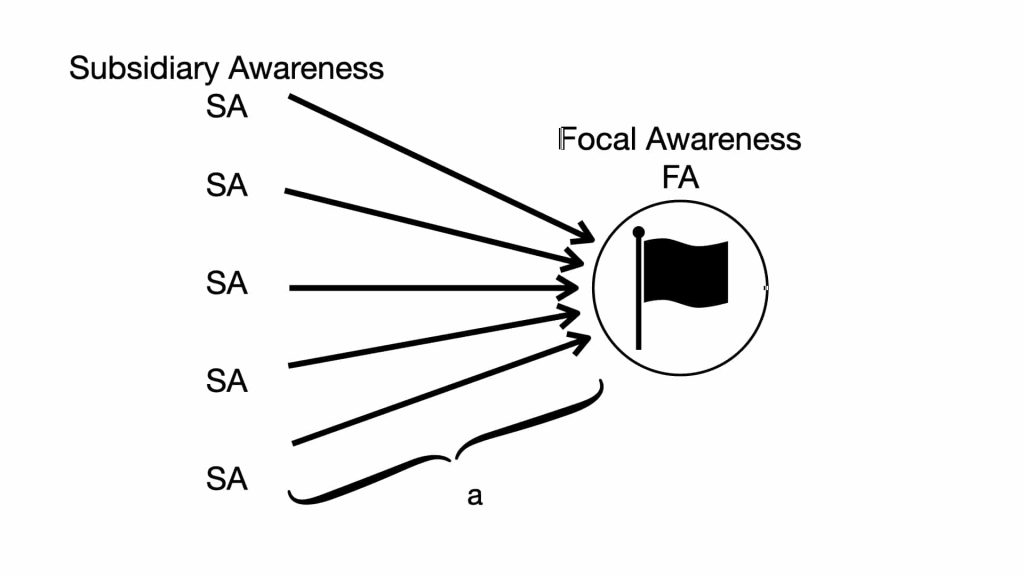
Fig. 4a
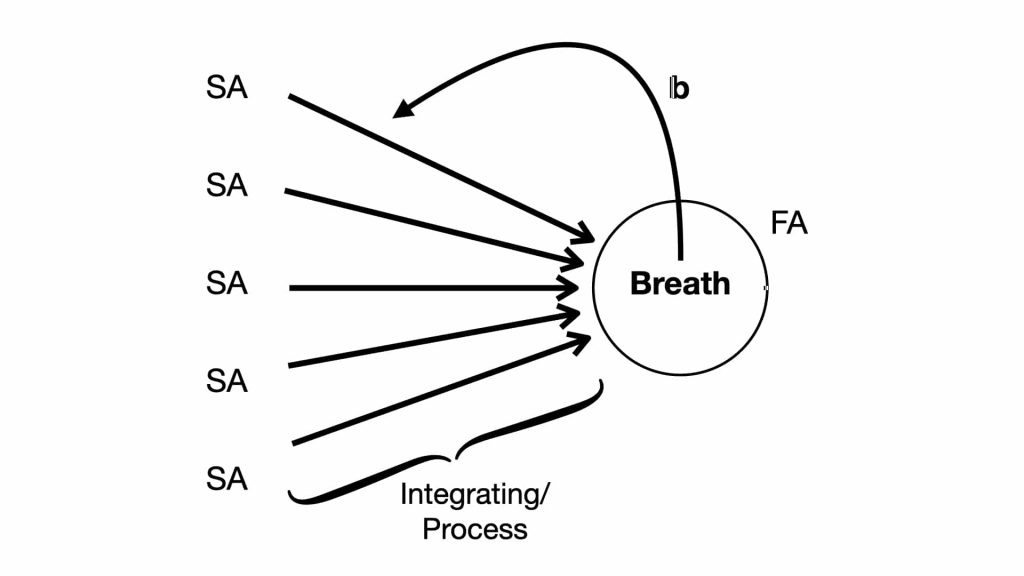
Fig. 4b
So by contemplating the flag the Patriot is bringing up all kinds of emotions and associations and other things - and think about the cerebellar activity here - and integrating them together. By looking through all of these - and think about the metaphor; “by looking through” - by looking through all of these things, like (demonstrates on the board through Fig. 4a, a) I'm looking through all of these different subsidiary things onto the flag, and by doing that I'm actually integrating all of these aspects of myself together and I'm becoming more patriotic. I'm actually participating in patriotism.
Focusing On The Breath
That's powerful, right? Now, put that together with what I just did: I'm looking at my breath (changes the flag in the diagram to “breath” (See Fig. 4b), and I'm doing all this and the point about all of this is to [-] integrate all of my processing together. But what can happen…/ And that's one way in which my breath is symbolic! So one way in which my breath is symbolic is it gives me a focal thing that I'm aware of, I can activate all of this stuff and I can integrate myself onto the thing; I’m becoming somebody else. But, as I just said a few minutes ago, the thing is the breath can also suddenly disclose reality to me (Fig 4b, b). The breath can also reveal an aspect of reality. Okay, let's try and put this together very carefully here. (Wipes board clean.)
At one stage, I'm doing this (Fig 5a - draws converging arrows as in Fig. 4a&b) and what I'm interested in is this, this is my Inherent Interest (labels these arrows “I.I.”). Although my Focal Awareness is here (circle - FA), I'm focusing precisely because I'm trying to, via a metaphorical process by looking through all of these subsidiary elements, I'm actually integrating them together. I'm not actually trying to get an insight like I normally do in metaphor, but what can happen is [that] I can actually get an insight! This (Fig5b, circle) can suddenly reveal aspects of the world to me (Fig 5b arrows), the impermanence and interconnectedness. And now I'm actually interested in my breath, because my breath is a symbol in another sense! My breath is a symbol in that it allows me to see into the impermanence and interconnectedness of reality. Notice what could happen is I can resonate between these (Fig 5, arrow r).
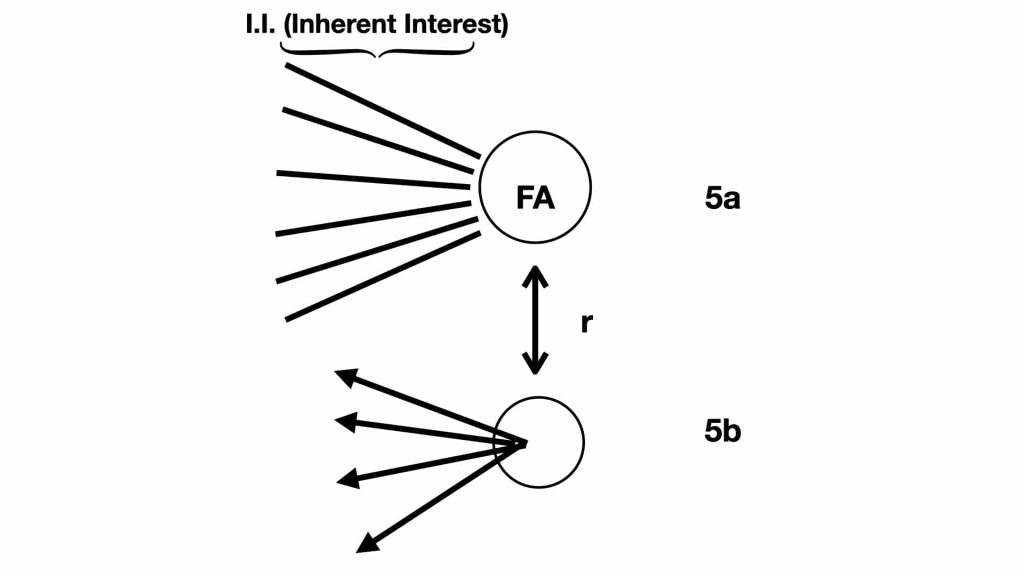
Fig. 5
Okay, let's do it: I'm looking at my breath. I become more integrated and precisely because I'm much more integrated, my processing becomes more powerful. And then suddenly what happens is I see something in my breath. I get a realization. The world is disclosed to me and that opens me up in powerful ways. And then now, when I refocus on the breath again, now I'm reintegrating all of that. But then what can happen is [that] now, as I reintegrate and re-coordinate again, I can more deeply see into what the reality of my breath is disclosing to me and I move more deeply. Do you see what I'm saying? You get this symbolic resonance that's going on. As I see more deeply into the object, it draws me in, and then that affords much more powerful integration, but the much more powerful integration actually coordinates my cognition much more so [that] I can see more deeply into the reality, if I'm relating to it symbolically.
Symbols are in this sense capable of affording Anagoge. They are capable of giving you this capacity whereby I get inner-optimization and then I see more deeply into the thing. And then by seeing more deeply into the thing, I get more inner optimization and the whole process flows Anagogically. So I'm looking at the balance, and then I activate all of this machinery and then I look through it at the symbol, and I'm looking through it at justice and coordinating all the things. But then I start to see aspects in the balance that I hadn't seen before, precisely because of how sensitized I am to the symbol. I start to see how it's actually never completely stable; if you look at the pictures of the scales, they are often always off! Balance is something very much a process, not a thing. And then that causes me to activate different aspects of myself. This is like, if you remember, when the mother-in-law has the bi-directional insight; the Sensibility Transcendence. Not only seeing her daughter-in-law differently, but seeing her own seeing differently; that trans-framing.
So symbols have the capacity to do this. Let's return back to something that I think is purely symbolic, in the sense that I mean, which is music. So you're listening to the music, but it's not like when you're listening to a sound and you're trying to make out like, “What's that? What's causing that sound? Is it a tiger? Is it a noise in the bush…?” You're listening the music and although you're focusing on it, you're not trying to get behind it. You're, focusing on it because the way in which you're being integrated in, together by, onto the music is crucial. But then what happens of course, is that aspects of the music are disclosed to you and you realize things, you see things that you haven't seen before, and that changes and alters how you can then understand and listen to the music. And so you get drawn in, in a very powerful way.
Symbols And The Mysterious
Now let's put [-] all of this machinery together with another aspect of the symbol that I've already hinted at which is, of course, the way in which symbols are putting you into confrontation with what is potentially mysterious. So here's your frame (draws box - Fig 6, box 1), and here is a frame you aspire to, a more comprehensive one (draws larger, dotted box - Fig 6, box 3), and you need something that can reach you inside this frame (Fig 6, arrow 1), but it can't be totally captured by this frame (box 1), because if it's captured by this frame, you'll stay in this frame. It has to insinuate itself into this, but change stuff such that [-] it actually drives you to expanding your frame (Fig 6, arrow & box 2). So it has to both activate you, but draw you beyond yourself to a state of trajec— (pauses) I'm trying not to use some technical terms here!!
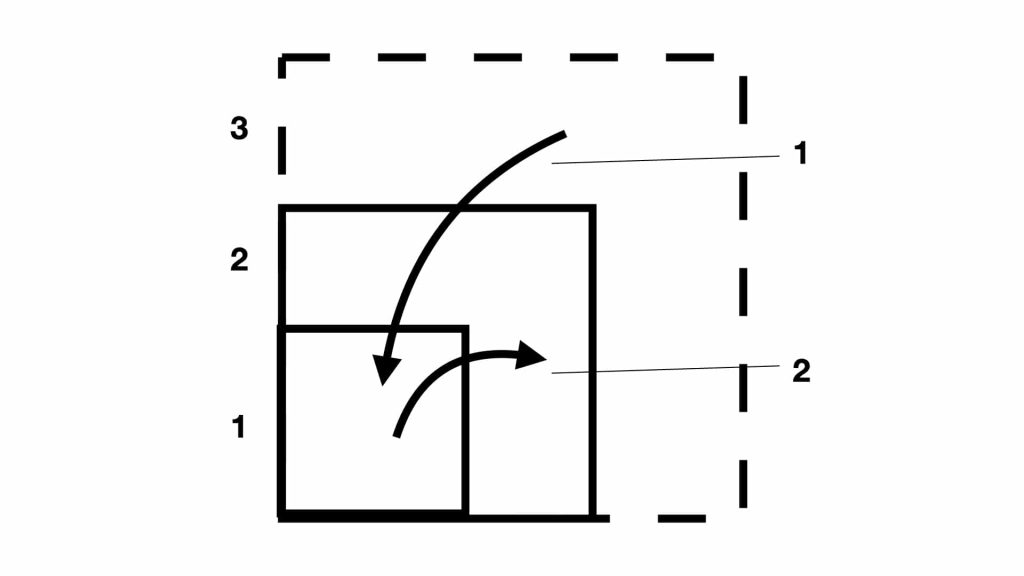
Fig. 6
What a symbol has to do is, it has to reach into your world view, but remember what the Gnostics we're talking about here! Remember how you're existentially entrapped! You want to be in another worldview, you want to find that world view viable. You need something that can come into this worldview, but won't be stable within it; it has to be transgressive, it has to shake things up and then put you into all of this machinery - all of this machinery that we've been talking about - but in a way that is making you move to and become capable of dwelling within that more expansive worldview. In this sense, symbols are deeply ecstatic (writes ek-stasis on the board) - we got our word ecstasy from this - but what this literally means is a symbol helps you to stand beyond yourself.
So let's go back to the example… I'm trying to use as many examples as possible! I've got the scales, I'm activating balance, that allows me to start doing the skills that gets me some sense of justice. I start to be able to see justice and realize justice in the world that I couldn't before because of my sensibility change, my skill acquisition, my sensibility transcendence. And that starts to make me more just. And then what's happening is my world is being opened up and, in a coordinated fashion, I'm being transformed to fit that expanding world. This is of course why symbols often are associated with wonder and awe, et cetera. So symbols are ecstatic in that fashion. As I've tried to show you throughout this, they're Participatory (writes this on the board below ek-stasis). And I’ve tried to show you how they're integrative, not just in a simple part: whole, but in the Anagogic sense - Sensibility Transcendence (writes Integrative - anagogic below Participatory). They're integrating you together, [-] they're integrating a new world together, and they're integrating that new world together as they're integrating you together in an integrated fashion.
So when a Christian sees the cross, first of all the cross is tapping into that exaptive machinery; it's taking all this perceptual machinery and it's playing with it - the vertical and the horizontal. That's being exapted, and all of that machinery that we normally look through is being exapted and is being used, and then we're looking into there… and if we are receptive - and of course the question is why some people are and why some people aren’t, right? - but if we're receptive, then that interaction starts to affect us! We start to become a different kind of person as we're integrated in our attention on the cross.
But that, of course, starts to also disclose to us aspects of reality that we normally might not be able to hold in mind, like suffering, like the relationship between eternity and time. And those goes from being ideas to things that we are confronting, engaging with, and they can draw us in which then of course integrates me more powerfully while disclosing a world. And if I'm willing to play the serious play with the symbol, I will start to be transformed in a coupled fashion to my world, such that perhaps Christianity becomes viable for me, for example. This is how symbols work. So they're integrative in the Anagogic sense. This is of course, if you remember, why people do things like Jeepform.
Finally, symbols are Complex (writes Complex below Integrative). And we have to remember: I'm using the scales to stand for justice, but justice isn't a single thing. And even when I talk about the breath and it's [-] showing me impermanence and interconnectedness, those aren't single static things. They are complex unfolding realities. So symbols often are multifaceted. You'll get Athena, she's the symbol of wisdom, but she's also the symbol of weaving! She's the symbol of warfare! All these different areas are actually being drawn together because the symbol is also the potential for radically reconfiguring the shape of your salience landscape, connecting things that you normally do not connect together, such that you might have an insight into reality.
Notice how the symbol is trying to do all of this! Because it’s trying to set you in motion! It's trying to get you to do this. (Draws out fig. 7 from the small box to the large, then the arrow - See Fig 7a). And in that sense, if you'll forgive the little bit of playfulness, it's ‘Epic’; it's trying to draw you into something E.P.I.C. (circles the acronym for Ek-Stasis, Participatory, Integrative & Complex. See Fig 7b). It's trying to afford a way in which you can radically open up your world in meta-commendation - triggering it, participating in it, confronting it - but also trigger your best machinery for being able to draw it into, relate it to who and what you are, so that you can become capable of dwelling within that expanded world. So meta-accommodation and meta-assimilation are both at work within the symbol.
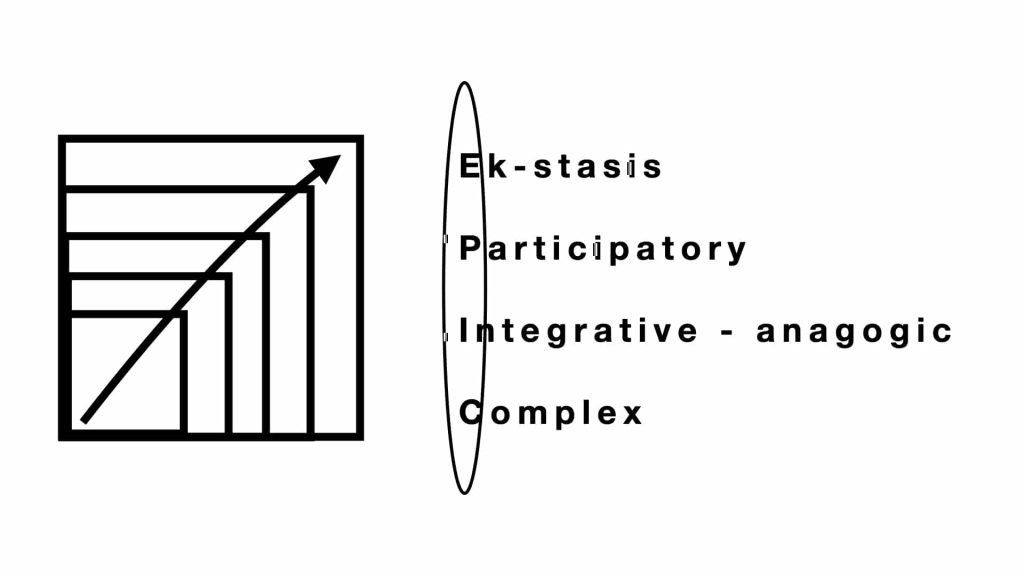
Fig. 7a Fig.7 b
How Symbols Relate To Sacredness
So, symbols are inherently transjective (indicates the dynamic in Fig.6) because they are between two worlds: the world you’re in/the framing you're in and the world you're trying to move to/the world that you aspire to. They are transgressive in all the ways I've tried to suggest to you. They try to trigger transframing. They're transformative. Now, how does all of that machinery relate to sacredness? Well, I've already shown you how it can be bound up with awe and horror and wonder, but let's try [to] make this a little bit more precise (cleans the board). I'm going to propose something to you. I'm going to propose that we can use this term [differently] - as I have been throughout the series (writes Mythos on the board). We don't mean…/ I’m going to use Mythos rather than Myth, to keep that distinction! By mythos I mean something that's always deeply connected to ritual, where ritual - and I've already argued this - doesn't mean some neurotic routine that I engage in!Ritual means enactive analogy, enactive Anagoge (writes ritual below mythos). It means the processes by which I try to activate the machinery of transformation. So when I'm saying ‘mythos’, don't just hear ‘patterns of representation’ hear ‘patterns of interaction’; these are deeply enmeshed together. And then what we have are symbols - in the way that I'm describing - and these symbols are always going to be enmeshed with story because you have to bring in the Perspectival, Participatory knowing - and we've talked a bunch about how important narrative is for participatory and perspectival knowing. And of course the story connects to the ritual, because if its ‘storied’, you can enact it (writes symbols to the right of mythos and story completing the square on the bottom right, with mythos also connecting to story - see Fig. 8a). Okay. So this is what I mean by mythos. This is what I mean by mythos (indicating the whole of Fig 8a).
When we have a mythos that is about Religio, such that we can activate Religio and seriously play with it in order to enhance it - enhance its capacities for meta-assimilation [and] meta-accomodation - that's sacredness. That's sacredness (Fig 8b). Of course we can invoke, we can make use of Mythos for other things, for other patterns that we care about. [-] Of course our Religio is always at work just in our day to day interactions with the world, but when we want to activate, accentuate, articulate Religio itself, we rely on Mythos to do that because our relationship to Religio is one that can only be born symbolically because of the primordial, participatory nature of Religio.
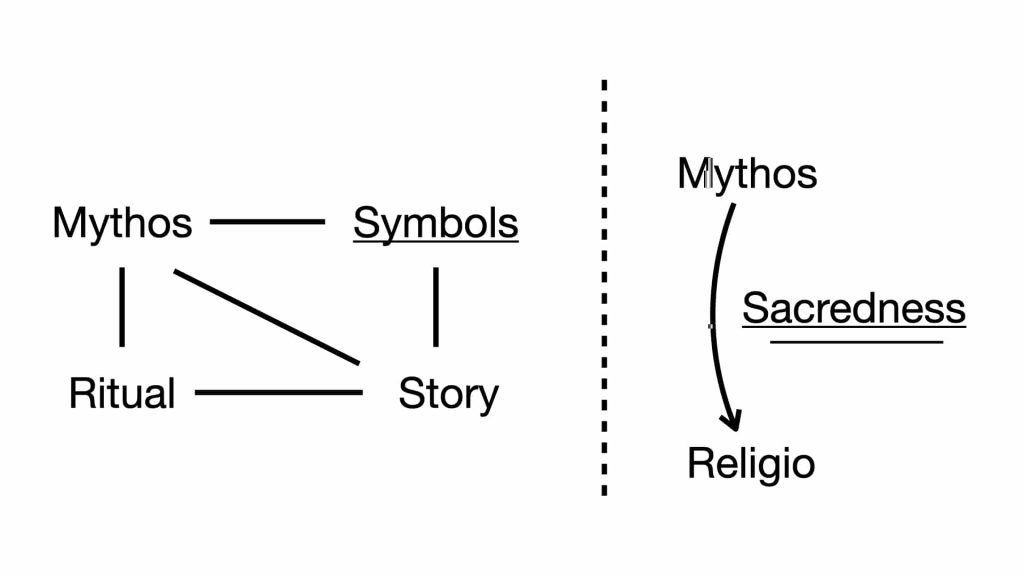
Fig. 8a Fig. 8b
Now here's something else: Of course, at the core of Religio, as I've argued, is Relevance Realization, and one of the things we know because of the phenomenon of insight and the phenomenon of flow, is one of the things that relevance realization is intrinsically interested in is itself. Relevance Realization, because it is a self-organizing, self-transcending, self-correcting process - remember, in insight you are correcting for a misleading salience pattern, given an incorrect problem formulation - Relevance Realization is intrinsically set up to be interested in itself it’s part of it's structural design. If your Relevance Realization machinery is not directed [-] to be interested in itself, it's ultimately not a self-organizing, self-correcting, self-developing process, which would mean it would cease to be relevance realization. It is constitutively necessary of relevance realization that it finds itself inherently interesting (see Fig 9).
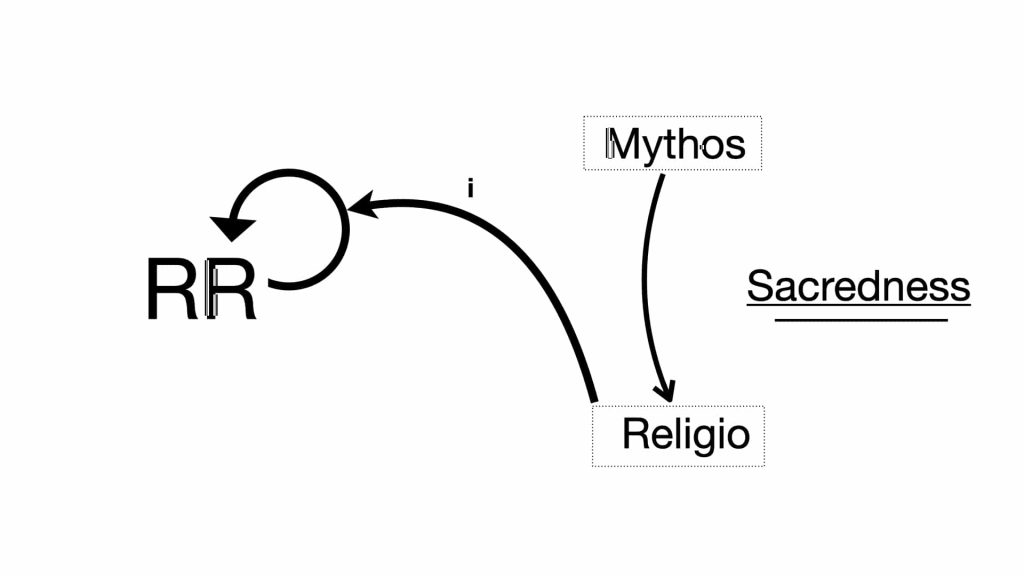
Fig. 9
So we can find the process… So this (buts a box around Religio in Fig 9) is just deeply valuable to us because it's constitutive of our being in the world. We can use this, mythos (boxes mythos) to activate, articulate, accentuate, celebrate Religio. And of course, we find that a deeply interesting thing to do (Fig. 9 arrow i) because relevance realization is set up, by it's evolutionary heritage, to be intrinsically interested in itself. And so we are going to find all of this deeply valuable, deeply meaningful. This is the machinery of meaning making (indicates Religio in Fig 9), and then we're using mythos to celebrate it and trigger the fact that relevance realization is constituted to finding itself interesting.
So what we have is, I think, a way of talking about a lot of the aspects of Sacredness. We get the experience of Sacredness out of the deep machinery of Religio and when we're using the centrally important machinery of Mythos to activate it, accentuate it, articulate it, celebrate it, and that in itself is developmentally important to us, [and] serious play is the way in which we go through development. But we also find that process intrinsically interesting - like an insight, or the flow state - precisely because relevance realization is constituted to reflectively be interested in itself as a process. Now, the question is: “Yes, okay, maybe all of that is right! Maybe what I'm doing in sacredness is using mythos in order to celebrate and appreciate and accentuate Religio, and I'm going to find that valuable because Religio is inherently valuable to me, and relevance realization is inherently interested in itself…. I get all of that! And I get why this can be so deeply transformative of people and why it can open up their world and open up themselves in this way that feels like making love with reality…. But still, you're not getting the essence of sacredness…?” Because the essence of Sacredness is in The Sacred (writes The Sacred on a cleaned board). And The Sacred takes us back to the metaphysical proposal.
The Metaphysical Proposal & Distinguishing Product From Process
The metaphysical proposal is the proposal that what ultimately generates the experience of Sacredness is something that [-] has an absolute [-] value because it has a particular metaphysical status, namely it is Supernatural (Fig. 10)) - it is above nature - and it's ‘above-ness’ means that it is always inherently valuable to us. And therefore we will find it sacred because of its absolute value. Now this carries with it a particular way of understanding the process of meaning making. It's to claim that, ultimately - I think that's what people are claiming - that there are things - maybe that's the wrong word, I don't [know], language is failing me! I'll use this word as neutrally as I can - there are ‘things’ that are always of relevance to us. What I'm suggesting to you is that this is the claim that there is an essence to relevance (writes this to the right of the list)! That there is a final formula for being relevant and that that essence inheres in some particular thing/object (Fig. 10 arrow i). And so if I come into the relationship with that object, the relevance, the essence of relevance is inhering in it and I will therefore find that object sacred!
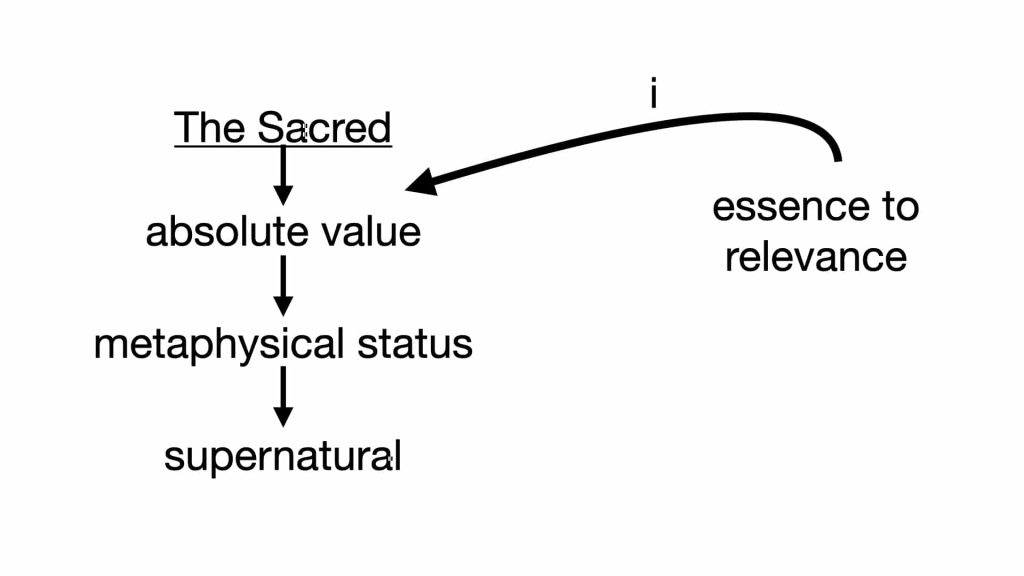
Fig. 10
I'm trying to be respectful here, but I think this is ultimately a mistake. The reason why I think it's a mistake is because there is no essence to relevance. There isn't even a thing, there is only the ongoing process of relevance realization. There is nothing other than itself that is intrinsically interesting to relevance realization. And the relevance realization isn't even absolutely interesting to relevance realization because, of course, your salience machinery can actually lead you to kill yourself! You may even find your own existence is no longer relevant or salient to you. So again, to say it's intrinsic, even that is not to say that it's absolute! The notion of sacredness here seems, to me, to be a category mistake. It seems to me to be saying that there is some-thing, some-one, some-place that essentially, absolutely, always is relevant! But that is to misunderstand the nature of relevance. It's to confuse the products of relevance realization with the process of relevance realization. And that of course is a hallmark of one of the ways in which we make mistakes. We get fixated on the products of our cognition and not paying attention to the process.
Let's go back to the Gnostics. Remember that one of the things that they're contemporary apostolic Christians criticised them for is that they were constantly inventing new myths, in this sense (as detailed above) - of mythos - because they saw the relationship to sacredness as an evolving one, a deeply transgressive one, a one that was supposed to always be launching you into a trajectory of trans-framing. Might that suggest another way of understanding sacredness? [One] that, I think, would be respectful to a lot of the texts considered sacred without committing us to, or needing the supernatural as a category? Or maybe [-] it means a significant [-] transformation of what we've ever meant by this term “Supernatural”, I don't know!
There's an inexhaustibleness in this whole process. There's a sense in which Reality can continue to disclose itself to me; it's inexhaustible. And that's ultimately, I think, because of the reality, that Reality is itself combinatorially explosive. There's an inexhaustibleness to the process of relevance realization, not in the sense that I'm infinite - that's ridiculous - but in the sense that the process is constantly evolving; it is constituted by its evolution, it is not something other than its evolution. What if sacredness is not about finding the completion, the essence, the stabilised final form? What if sacredness is actually an experience of the inexhaustibleness of reality and the inexhaustibleness of the relevance realization machinery and it's coupled response to that reality? What does that look like more concretely?
Let me give you an example of where you could see these two concretely distinguishing from each other. For me, Plato is Sacred. That doesn't mean that I think Plato has some absolute or supernatural value; that he has an unquestionable authority! Or that my understanding of Plato should be stabilised or finished or complete! Instead, what happens is exactly the opposite: I read some Plato and I understand some Plato - I get some insight - and that has an impact on me. And that does all of this (gestures to the board) to me, and then I go out in the world and that understanding - in a perspectival and participatory way - transforms me and I engage and I become, and the world discloses in a certain way. And after that process I return to Plato, and then I can see in Plato what I did not see before! I can realize things I did not see before and those realizations reach deeply into me again. And then again, there's that engagement, there's that transformation, and then I go out in the world… You see how I'm doing the Anagogic thing, right? I go out in the world and the world is disclosed to me in ways I hadn't seen before and then I go through transformation: I become something different, the world becomes different at the level of co-identification. Agent and Arena are being opened up. And then I go back and when I read Plato I see something again that I didn't see before… And that has happened to me throughout my life! There isn't some final form there! I'm meaning this very carefully: this is a “Gnostic” - not in the sense of the two world mythology or something like that - there's Gnosis here: I am constantly finding Plato to be fount, an inexhaustible fount of insight, transformation, an inexhaustible source of trans-framing of my world and who I am. If it's ongoing it's filled with a kind of developmental wonder for me. I don't think Plato is supernatural. I don't think Plato is absolute. I don't think Plato has the final account. I don't think Plato can give me a final definition of what is relevant. But nevertheless, again and again and again, I get into symbolic resonance with the text; I see through it and then the world reaches back through it to me.
I mean, even Nietzsche has this, right? “If you stare long enough into the abyss, it begins to stare back through you.” He has a kind of sacredness around that. But it's of course open-ended, it's deeply symbolic - read “Also sprach Zarathustra”. But as I said, I think it's bound up with a problematic grammar of simply inverting Christianity. I don't want to invert Christianity. That's not what I'm proposing to you, at all. I'm trying to suggest to you that the idea I propose to you about what Sacredness is, can be connected to an alternative proposal of what The Sacred is. The sacred is the Transjective relationship between the combinatorially explosive nature of Reality - that reality is ultimately a no-thing-ness, that ultimately it is not a thing that you can frame. Reality will always transcend your framing. That's what ‘combinatorially [explosive]’ says. And this is linked to the no-thing-ness of yourself! The ‘I’ that can never be captured, the framing that can never be captured in the frame, the ongoing, never ending - not in you, particularly, but as a process. It doesn't come to a completion is what I meant by ‘never ending’ - process of Relevance Realization. There's a deep, non-logical identity, a deep symbolic resonance between these two (Fig 11. Arrow i). I think it's what a lot of the mystics were talking about! This is a deep, participatory identification: the inexhaustibleness of Reality, and the inexhaustibleness of Relevance Realization are deeply, deeply coupled at the primordial levels of Religio. This is The Sacred as this (gestures to the board - See Fig 11), the inexhaustible that powers the experience of Sacredness in a deeply, profoundly, participatory fashion.
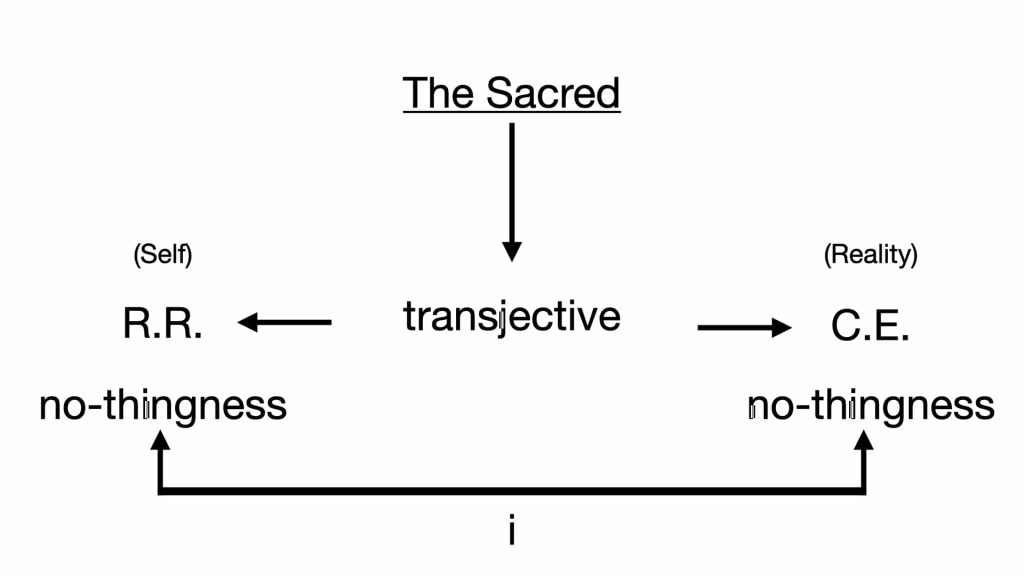
Fig 11
Thank you very much for your time and attention.
- END -
Ep. 35 - Notes
To keep this site running, we are an Amazon Associate where we earn from qualifying purchases
Vilayanur Subramanian Ramachandran
Vilayanur Subramanian Ramachandran (born 10 August 1951) is an Indian-American neuroscientist. Ramachandran is known for his wide-ranging experiments and theories in behavioral neurology, including the invention of the mirror box.
Book Mentioned:
The Emerging Mind: The BBC Reith Lectures - Buy Here
The Tell Tale Brain: Unlocking the Mystery of Human Nature - Buy Here
Michael Polanyi (flags as symbols)
Book Mentioned: Charles Taylor, Michael Polanyi and the Critique of Modernity - Buy Here
FOUND INSIDE – PAGE 184
Here, again, I believe Taylor's approach could benefit from Polanyi's explication of how symbols work in Meanings (with ... a unity and project it beyond the symbol, which may have no intrinsic interest in itself (e.g., the flag; metaphors, however, ...
ek-stasis
Ékstasis (ἔκστασις) is the Ancient Greek word for ecstasy.
Ecstasy (from the Ancient Greek ἔκστασις ekstasis, "to be or stand outside oneself, a removal to elsewhere" from ek- "out," and stasis "a stand, or a standoff of forces”.
Also sprach Zarathustra - Nietzsche
Thus Spoke Zarathustra: A Book for All and None(German: Also sprach Zarathustra: Ein Buch für Alle und Keinen, also translated as Thus Spake Zarathustra) is a philosophical novel by German philosopher Friedrich Nietzsche, composed in four parts written and published between 1883 and 1885.
Book Mentioned: Also sprach Zarathustra - Buy Here
Other helpful resources about this episode:
Notes on Bevry
Additional Notes on Bevry


